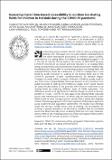Files in this item
Assessing travel time-based accessibility to outdoor ice skating fields for children in Helsinki during the COVID-19 pandemic
Item metadata
| dc.contributor.author | van der Lijn, Charlotte | |
| dc.contributor.author | Nurmi, Marisofia | |
| dc.contributor.author | Hasanen, Elina | |
| dc.contributor.author | Pyykönen, Janne | |
| dc.contributor.author | Salmi, Lotta | |
| dc.contributor.author | Salmikangas, Anna-katriina | |
| dc.contributor.author | Vehkakoski, Kirsi | |
| dc.contributor.author | Virmasalo, Ilkka | |
| dc.contributor.author | Toivonen, Tuuli | |
| dc.contributor.author | Muukkonen, Petteri | |
| dc.date.accessioned | 2023-01-12T15:30:19Z | |
| dc.date.available | 2023-01-12T15:30:19Z | |
| dc.date.issued | 2022-12-23 | |
| dc.identifier | 282748297 | |
| dc.identifier | 3993924f-d70d-42be-af64-78e593ad17ab | |
| dc.identifier.citation | van der Lijn , C , Nurmi , M , Hasanen , E , Pyykönen , J , Salmi , L , Salmikangas , A , Vehkakoski , K , Virmasalo , I , Toivonen , T & Muukkonen , P 2022 , ' Assessing travel time-based accessibility to outdoor ice skating fields for children in Helsinki during the COVID-19 pandemic ' , Fennia - International Journal of Geography , vol. 200 , no. 1 , pp. 6-23 . https://doi.org/10.11143/fennia.114590 | en |
| dc.identifier.issn | 1798-5617 | |
| dc.identifier.other | crossref: 10.11143/fennia.114590 | |
| dc.identifier.other | ORCID: /0000-0001-5538-0432/work/125631199 | |
| dc.identifier.uri | https://hdl.handle.net/10023/26751 | |
| dc.description | This paper was written within the research project called “Equality in suburban physical activity environments, YLLI” (in Finnish: Yhdenvertainen liikunnallinen lähiö, YLLI) funded by the Suburban Programme 2020–2022 (in Finnish: Lähiöohjelma 2020–2022, decision number VN/10837/2020). | en |
| dc.description.abstract | Informal sport is central to Finnish children’s leisure and physical activity time. This paper aims to build a better understanding of the travel time-based accessibility to informal sports facilities, specifically to ice skating fields, for children and adolescents (aged 7–19) in the city of Helsinki. We focused on the winter of 2020–2021 because COVID-19 restrictions on indoor activities resulted in ice skating fields being among the few public facilities that could remain open. Additionally, the weather was favourable for maintaining outdoor ice skating fields. We analysed if there would be a difference in children’s independent travel times by public transport or walking to ice skating fields due to the COVID-19 pandemic related recommendations by Helsinki Region Transport to avoid public transport. Children in Finland usually travel to and from school independently. Hence we focused on the transition from public transport to walking and omitted car usage, which would require an adult. We also looked at the potential differences in travel time to ice skating fields by analysing different types of fields separately. This difference would be of significance if climate change resulted in warmer winters in Finland. Helsinki has two types of ice skating fields: naturally frozen and mechanically frozen, of which only the mechanically frozen fields would be used during a warmer winter that is above zero degrees Celsius. We took a geographic information systems (GIS) analysis approach using travel time and population catchments. The study’s main findings show that during a milder winter and by walking, the accessibility for children is greatly reduced to 55.2%; that is, children face an increased travel time when naturally frozen ice skating fields are not in use. However, almost 100% of the child population can access both types of fields within a travel time of 30 minutes by public transport. | |
| dc.format.extent | 18 | |
| dc.format.extent | 4370448 | |
| dc.language.iso | eng | |
| dc.relation.ispartof | Fennia - International Journal of Geography | en |
| dc.subject | Covid-19 | en |
| dc.subject | Spatial accessibility | en |
| dc.subject | Geographic information systems | en |
| dc.subject | Grid cell data | en |
| dc.subject | Ice skating | en |
| dc.subject | Informal sports | en |
| dc.subject | GIS | en |
| dc.subject | G Geography (General) | en |
| dc.subject | 3rd-DAS | en |
| dc.subject | SDG 11 - Sustainable Cities and Communities | en |
| dc.subject | SDG 13 - Climate Action | en |
| dc.subject | AC | en |
| dc.subject | MCC | en |
| dc.subject.lcc | G1 | en |
| dc.title | Assessing travel time-based accessibility to outdoor ice skating fields for children in Helsinki during the COVID-19 pandemic | en |
| dc.type | Journal article | en |
| dc.contributor.sponsor | Ympäristöministeriön asettama lähiöohjelma | en |
| dc.contributor.institution | University of St Andrews. School of Geography & Sustainable Development | en |
| dc.identifier.doi | 10.11143/fennia.114590 | |
| dc.description.status | Peer reviewed | en |
| dc.identifier.grantnumber | en |
This item appears in the following Collection(s)
Items in the St Andrews Research Repository are protected by copyright, with all rights reserved, unless otherwise indicated.

